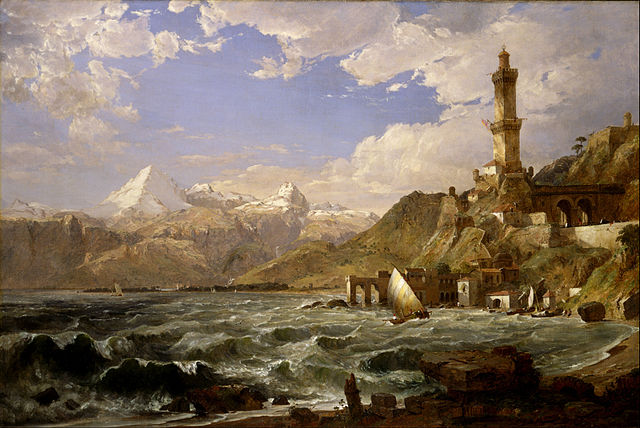
March 10, 2017, by Harry Cocks
The Botanical History of Genoa through the eyes of John Ray and Francis Willughby, 1664 to the Present
What can the botanical history of a place give to contemporary urban planning and cultural heritage? This is a question addressed in a new paper in Landscape History (see link) by Ross Balzaretti (Nottingham History), Charles Watkins (Nottingham Geography), Raffaella Bruzzone (Marie Curie fellow, Nottingham), and Carlo Montanari (University of Genoa). The authors have used records initially collected in the seventeenth century by the English naturalists John Ray and Francis Willughby (of Wollaton Hall) to analyse the natural history of the area surrounding Genoa’s famous lighthouse. In addition, they used artistic depictions of the area (topographical art) to show how the city’s natural heritage is still relevant today.
A lighthouse at Genoa has existed on a promontory to the west of the harbour below the St Benigno Hill since 1128. It was rebuilt in 1543 and has been described by many English travellers since the diarist John Evelyn visited the city in October 1644. It was painted by J. F. Cropsey in 1854 (top right). Ray and Willughby’s collections were made on the site in March 1664 during a three-year tour of Europe, and the former’s collection, the Historia Plantarum (1686-8), which contains pressed specimens and descriptions of the plants collected, is held at University of Nottingham. Many of these plants are illustrated in the article. In spite of fact that much of the hill on which the lighthouse is situated has been lost to quarrying, these records, in addition to surveys made between September 2014 and September 2015 show that there was substantial continuity of species at the site. The surveys identified nine species (including Pitch trefoil, silver ragwort, Yellow fleabane, Spanish broom and Sweet alyssum) of plant on the rocks and walls round the lighthouse identified by Ray along with 28 others.
The aim of the research was also to engage local planners and conservationists in the natural history of Genoa, and this was done at an event in September 2014 attended by members of the Giovani Urbanisti Fondazione Mario e Giorgio Labo group of Genoese urban, land and environmental planners. A guided walk around the lighthouse rock was also conducted. The research results provides evidence which allows the Giovani Urbanisti to increase interest in this symbol of the city, its semi-natural heritage and biodiversity. The authors and the planners also aim to encourage locals and tourists to take greater interest in the landscape and botanical heritage of the city.
The history of urban plants can be examined to assist conservation policies and give new value to ephemeral species, as well as to the archives concerned and the place itself. The research brings natural history out of museums and into the field, as something that can be engaged with by a broader public. Even in heavily urbanised areas a continuous natural history and biodiversity can be demonstrated and shown to be an important part of Genoa’s cultural heritage.
Raffaella Bruzzone, Charles Watkins, Ross Balzaretti, Carlo Montanari
“Botanical relics of a lost landscape: herborising ‘upon the Cliffs about the Pharos’ in Genoa, March 1664”, Landscape Research (2017)
http://dx.doi.org/10.1080/01426397.2016.1274966

I an delighted to read this abstract. I have visited Genoa on many occasions and I live near Wollaton Park. It is fascinating to read something that ties the two together over time. The history of the Willoughby family is very interesting and continues to add appreciation of their Wollaton home and deer park.